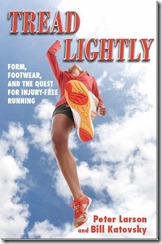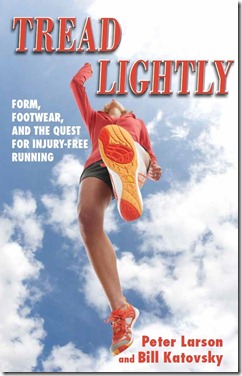 A few days ago I had the pleasure of speaking with journalist Phil Latter about my book, Tread Lightly: Form, Footwear, and the Quest for Injury Free Running. We talked about quite a number of topics, and the interview has now been posted on the Runner’s World website.
A few days ago I had the pleasure of speaking with journalist Phil Latter about my book, Tread Lightly: Form, Footwear, and the Quest for Injury Free Running. We talked about quite a number of topics, and the interview has now been posted on the Runner’s World website.
Here’s an excerpt:
Phil: What first caught my eye in Tread Lightly was the way you examined the whole supination/pronation paradigm and found that there is absolutely no conclusive evidence that it should be used as a means for shoe fitting. What spurred you to look at that critically?
Peter Larson: When I started running seriously five years ago, I went to a specialty running store and got fitted for shoes by having the [salespeople] watch me run across the store 10 feet. They said, “You’re a mild pronator – you should probably have some stability in your shoes.” I didn’t think anything about it at the time. I wore some variant of a stability shoe for about two years, and then I read Born to Run. That kind of got me wondering if there is really a lot of science behind this whole business. And I bought a pair of Nike Frees. That was kind of my first exploration with less shoe. I ran in them, and I was just amazed by how much lighter and more flexible they were.
The fact that I was able to run in them, even though I was told I needed a stability shoe, led to one thing after another and I came to find that there really isn’t a whole lot of good science supporting the whole paradigm that we should fit people based on how much they pronate. [Then] you get to talking to people like Jay Dicharry (who runs the SPEED Lab at the University of Virginia) and you find that arch height is pretty meaningless when it comes to fitting shoes because what the arch does when you run is very different than what it does when you stand.
You can read the full interview here, and there is much more detail on the pronation control shoe-fitting paradigm in Chapter 6 of my book.
















This is very similar to my experience. As an engineer, I always thought that it was odd that our heels are nice and round
and running shoes are flat. It seemed obvious that the wide flat soles would exaggerate any pronation or suppination. Prior to the Nike Free series, I would run in the most neutral shoes I could buy
and lace them loosely, allowing my heels to move freely within the shoe. I bought Nike Frees as soon as they were available. I really appreciate your blog. It has given me a new perspective on running as well as shown me many ways where I may improve – even after 27 years of running 1500 miles per year.
Thanks Jimmy!
—-
Pete Larson’s Web Links:
My book: Tread Lightly – link to ow.ly
Work: link to anselm.edu…
Blog: https://runblogger.com
Dailymile Profile: link to dailymile.com…
Twitter: link to twitter.com
Does the link work for you guys?